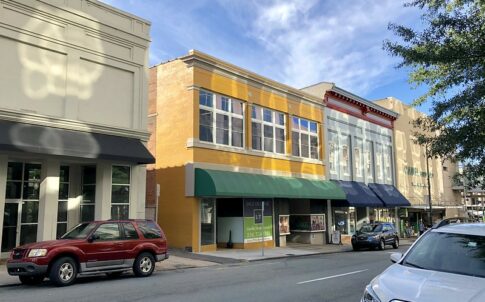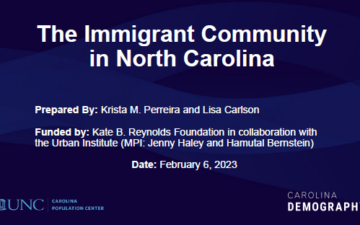Which county in NC is most like the state?

Picture this: You’re at a demography dinner party. (Let’s pretend we can have dinner parties again.)
And the demography enthusiast next to you says, “Hey! Got a question for you. Which county in North Carolina is most like the state?”
How would you answer?
First, you’d want to know what parameters to include – e.g. what factors to consider in thinking through how to calculate your answer. To do that, we can start with an NPR story from 2016 from reporter Asma Khalid, in which she came “up with which states actually were the most representative of the average of the entire country, in what [she called] the Perfect State Index. In creating the PSI, [she] looked at five categories: race, education, age, income and religion.”
We liked Khalid’s approach so decided to create a composite index score of our own for NC counties. We used data from five different indicators: demographic composition; median age; median home value; median household income; and the percent of residents 25+ who hold at least a bachelor’s degree. The values for each were then compared to the same indicator for the entire state. The counties are ranked by how far away they are from the state number. Rankings are determined for all five topics. Counties who have differences that are far above the state, as well as those far below, are equally “unlike” the state.
The ranks are then combined to create a final composite “score.” The lower the final score a county has, the closer they are to the state. The lowest theoretical score is a 5, meaning that the county ranked 1st for every indicator, and thus would be the closest to the make-up of NC on all dimensions. The highest is then a 500, meaning they rank last in each. However, neither of those situations ended up occurring.
As Khalid said, the methodology behind choosing these indicators is “somewhat arbitrary.” The possibilities for comparison are endless. We used her piece as a springboard, and decided to choose some different indicators. (If you decide to replicate this at your own demography dinner party, we’d love to know which indicators you choose.)
The county which had the lowest overall composite index score, ranking them as “most like the state,” is Forsyth County.
Located in the Triad Region of NC, Forsyth is the fourth most populous county in the state, as of the 2020 decennial census – only Wake, Mecklenburg, and Guilford have larger populations (in that order). Forsyth is home to Winston-Salem, the city with the fifth highest population across NC. In fact, that city accounts for roughly 65% of the county’s total number of residents. Over the last decade, Forsyth County grew by 9% - the same rate at which all of NC grew in that time. 23 out of our 100 counties grew by a higher rate.
While Forsyth ranks number one in the overall index, it was not first in any of the individual subcategories. Forsyth’s highest rank was in the age category, where it placed second. The median age of North Carolinians was 38.7 in 2019, according to the American Community Survey (ACS). Forsyth County had a median age of 38.4, a difference of only 0.3.
Forsyth finished first in the overall ranking after placing in the top 25 of every indicator, including a top ten placement in three of the five. Have a look at the final table below, then we’ll break down the indicators and see who was number 1 for each.
Here is the demographic composition – as of the 2020 decennial census – for the state of North Carolina, in order of largest to smallest group:
To rank counties for the index, we subtracted their respective values for each of these categories from the ones you see above. For example, Alamance County’s population was 67% white, a difference of 7 percentage points. The total sum of these differences was then taken and used to compute who is furthest away from the state in terms of total composition. Cabarrus ranked number 1, being the only county to fall within 3% (+/-) of the state composition for Non-Hispanic White, Black/AA, Hispanic, Asian, and Multi-Racial. Bertie County ranked last.
According to the latest American Community Survey (ACS) Data, the median North Carolinian household brings in $54,602 per year. New Hanover County – with a median household income of $54,891 – comes closest to this figure. Franklin County, at $55,193, is not far off either.
$260,597 is the median price of what is required to purchase a house in North Carolina, according to Zillow. 25 counties have a median home value higher than the state.
The amount you would save buying a house in Washington County – the lowest median home value at $70,154- rather than in Dare County – the highest median home value in the state at $430,215 – comes out to $359,971. That difference is enough to buy the median home in all but 8 counties in North Carolina.
If you ignored this variation and were budgeting to spend a dollar amount closest to the statewide median, you would have the most luck in Macon County. The median price of a home there is $256,277, landing it $4,320 below the statewide median.
Nearly one in three (31.3%) of all residents 25+ have a bachelor’s degree or higher, according to the ACS. These residents are heavily concentrated in urban counties: 86 counties have a lower bachelor’s attainment rate than the state. Orange County, home to UNC-Chapel Hill, has the most, with just under 60%. Henderson County ranked number 1 in this portion of the index. Their bachelor’s attainment rate of 31.8% brings them within only half of a percent of the entire NC population.
The age category brings us our only tie, which is between the counties of Lee and Pasquotank. Both have a median age of 38.6, falling only 0.1 years short of the state. Not surprisingly, the oldest county in NC, Brunswick, finished last with a median age of 53.8 years old.
So, after using all the above to defend your stance as to why Forsyth County is most like the State of North Carolina, your dinner mate says “Well what if I picked five completely different indicators to answer the same question? Would Forsyth still be the correct answer?”
The answer could be yes, or no. Remember, these are arbitrary points of comparison. Asma Khalid did not use the exact same ones we did because we were asking two different questions (besides the fact that she compared states and us counties). Switching out an indicator to match her five might result in a different county ranking first in this index, and that would not make either wrong.
Why you ask the question determines how you answer it, and that then decides the outcome. There is no exhaustive list that exists in the world that will ever identify every single point of comparison you could use. As long as you can back up your answer with why and how you got there (and accurate data, of course) you will be able to defend what you find.
And then you can ask for dessert.
Need help understanding population change and its impacts on your community or business? Carolina Demography offers demographic research tailored to your needs.
Contact us today for a free initial consultation.
Contact UsCategories: Fun Maps, NC in Focus

The Center for Women’s Health Research (CWHR) at the University of North Carolina School of Medicine released the 12th edition of our North Carolina Women’s Health Report Card on May 9, 2022. This document is a progress report on the…

Dr. Krista Perreira is a health economist who studies disparities in health, education, and economic well-being. In collaboration with the Urban Institute, she recently co-led a study funded by the Kate B. Reynolds Foundation to study barriers to access to…

Our material helped the NC Local News Lab Fund better understand and then prioritize their funding to better serve existing and future grant recipients in North Carolina. The North Carolina Local News Lab Fund was established in 2017 to strengthen…
Your support is critical to our mission of measuring, understanding, and predicting population change and its impact. Donate to Carolina Demography today.